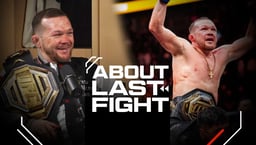When Fedor Emelianenko stood across the ring from Antonio Rodrigo ‘Minotauro’ Nogueira in the Yokohama Arena, Japan, before their Pride 25 heavyweight title bout in 2003, few gave the Russian a chance. ‘Big Nog’ was an unstoppable jiu-jitsu machine in his prime: a granite-chinned submissions master who had just avenged his only loss against Dan Henderson and was smashing through the ranks of challengers with an incredible 13 straight victories.
Then 20 minutes later, the MMA world had a new hero. Fedor, until then categorized as a striker, had taken down Nogueira almost at will and easily evaded the Brazilian’s submission attempts. Nogueira’s guard, so deadly to other opponents, had simply been a comfortable base for Fedor to launch a devastating ground ‘n’ pound attack that ultimately won him a unanimous decision victory.
The wrestling skills and submission defense of Emelianenko were sublime, yet he had studied neither Brazilian jiu-jitsu nor any Olympic wrestling. Instead he was a product of Russia’s own martial art, sambo.
The word ‘sambo’ is an acronym for Samozashchita Bez Oruzhiya, which in Russian means “self-defense without weapons.” Confusingly, it is sometimes referred to as ‘sombo’ in the west due to the coincidental racial connotations of the word in English.
Founded in the early 20th century by Vasili Oshchepkov and Viktor Spiridonov, it grew from its roots in judo to encompass different styles of folk and freestyle wrestling from across the former Soviet Union.
Most competition sambo, known as sport sambo, involves only grappling but, unlike judo, forbids chokes while permitting leg locks. An American variant, freestyle sambo, broadens the scope of allowed techniques but still does not allow striking. It was the final variant that made Fedor such a handful in mixed martial arts: combat sambo.
Combat sambo rules vary from organization to organization but in tournaments in Russia it’s common to see a full range of striking, choking, neck-cranking, leg-locking and bent joint locks. Head-butts are allowed too, so competitors wear head protection. Apart from the headgear, gloves and gi-jackets, it very much resembles the ‘good old days’ of no-holds-barred fighting in early UFCs and Brazilian vale tudo that would eventually become modern MMA. This tough style is no surprise when the military origins of sambo are considered.
Fedor isn’t the only sambo champion to cross over into mixed martial arts. His teammate Volk Han was one of the first, fighting in the Japanese Rings promotion as early as 1995. Fedor’s brother and fellow Pride FC fighter Alexander Emelianenko was a three-time Russian national champ and three-time world sambo champion while ex-UFC heavyweight champion Andrei Arlovski was a world silver medalist.
Since that explosion of sambo talent onto the MMA scene in the late ’90s and early 2000s, however, there hasn’t been a major-promotion MMA champ with a predominantly sambo background. So, has sambo been overtaken by other styles or is this just a temporary lull?
According to Silviu Vulc, it’s just a matter of time before sambo produces a new star. Vulc is a heavyweight MMA fighter and ex-Olympic boxing coach who placed fifth in the combat sambo world championships after spending two years training alongside Fedor and Alexander under their head coach Vladimir Voronov at the Red Devil Sport Club.
He currently coaches sambo for MMA in Thailand for the Phuket Top Team and points out that although there haven’t been many UFC sambo fighters, other promotions have featured crossover stars such as Guram Gugenishvili (M-1 Global heavyweight champion) and Shamil Zavurov (former M-1 Global welterweight champ and three-time World Combat Sambo champion).
The ‘mixed’ in mixed martial arts is often not an especially varied blend. Muay Thai, BJJ and wrestling still form the basis of most fighters’ skill sets with occasional exceptions like Lyoto Machida’s karate and Yoshiro Akiyama’s judo. Yet Vulc believes that many fighters would benefit from including some sambo training to boost their overall game.
“Sambo is not the single answer but also sambo is not just one small thing. Sambo has so much to take into MMA,” he says.
“Sambo is not only leg locks: the striking and the takedowns and movement are very unique also. Sambo can use leg locks very well of course, but also people must be aware of the striking and use of the hips. We use hips to strike, hips to defend and hips to takedown.”
He says that even advanced Brazilian jiu-jitsu players can benefit from some sambo style, “to learn and increase [their] understanding. To see not only one way of being. To create posture and to learn from the ground the many options of striking. For combat sambo most submissions are made after striking, not only after slowly working for a technique.”
Robin Hyslop, chairman of the British Sambo Association and 2005 world masters silver medalist recalls agrees. He has sought out masters of Brazilian jiu-jitsu to learn from but feels there are some big differences between BJJ and sambo in terms of their mentality. “I trained with Carlos Gracie in the ’80s,” he recalls, “and with Royce Gracie just recently and the seminars were the same. The Brazilians have repetitive work whereas the Russians are more like, ‘Here’s the drill, it’s up to you if you use it or not.’ You make it work for yourself.”
Scott Sonnon, former USA National Sambo Team coach, founder of RMAX international and author of Sonnon Sambo for MMA and Mastering Sambo for Mixed Martial Arts believes sambo has also evolved as a result of exposure to MMA. “By facing the dominance of positional submission fighting from Brazilian jiu-jitsu, sambo both addressed a weakness, and developed an attribute,” he explains.
“Sambo addressed a weakness in the BJJ approach to MMA, in that instead of attempting to pass the guard, sambo offered the chance to attack the guard itself with leg submissions. BJJ’s sophistication of positional fighting forced sambo to develop a positional sophistication to leg lock entries, structure and transitions.”
Sonnon believes sambo still has an important role in MMA, explaining: “The average MMA fighter still lacks a positional fighting understanding of the lower-half on the ground. They must shore up this gap and learn how to control the positions from hips down, as they do from belly up from jiu-jitsu.
Certainly this isn’t sambo’s only contribution to MMA, but it’s a glaring hole, which sambo uniquely and lethally fills. A fighter could be completely prepared on sambo alone, but hybrid fighters must address this hole which only sambo resolved.”
According to Hyslop, the key lessons for MMA fighters to take from sambo would be, “entry drills to grab the legs for leg locks. Huge throws can be taught by judo players – they’re the same in every language. But there’s a hell of a lot to sambo leg locks. They’re very technical. We sometimes do seminars on leg locks only. They’re very volatile, very painful and highly dangerous,” he says.
‘Volatile and highly dangerous’ is a good description of UFC welterweight Nick Diaz who represents this new generation of sambo-influenced athletes from other backgrounds. Nick has trained in sambo with Bulgarian national champion and world silver medalist Val Ignatov for over 12 years. While the purest sambo pedigree in top-level MMA currently belongs to UFC lightweight prospect Habib Nurmagomedov, who has won the World Combat Sambo Championship three times.
Most fight fans will have watched Rocky IV (whether they admit it or not) and will be familiar with the montage of Ivan Drago using cutting-edge scientific fitness regimes while Rocky stumbled around in the woods, chopping down trees. It’s therefore ironic it was perhaps the advances in conditioning and weight-cutting in western MMA that caused Fedor to lose his status as the most dangerous heavyweight in the world.
Sambo remains an excellent base for MMA and a fascinating art in which to cross-train for fighters looking for an edge. But be careful, as Hyslop has some words of caution. “There are a lot of people who’ve had a couple of lessons in sambo and all of a sudden they’re coaches,” he says. “It’s a lot better organized now, with grades and levels of coaching and we’re starting to get big numbers at the tournaments.”
So, find a qualified coach near you and see if sambo can help you to the top of the MMA tree.
Sambo is a booming sport that hopes to attain Olympic recognition soon. As with many martial arts there are many organizations and splinter groups but the closest thing to a recognized international association is FIAS (Federation International Amateur de SAMBO). Its website is www.sambo.com.
...









